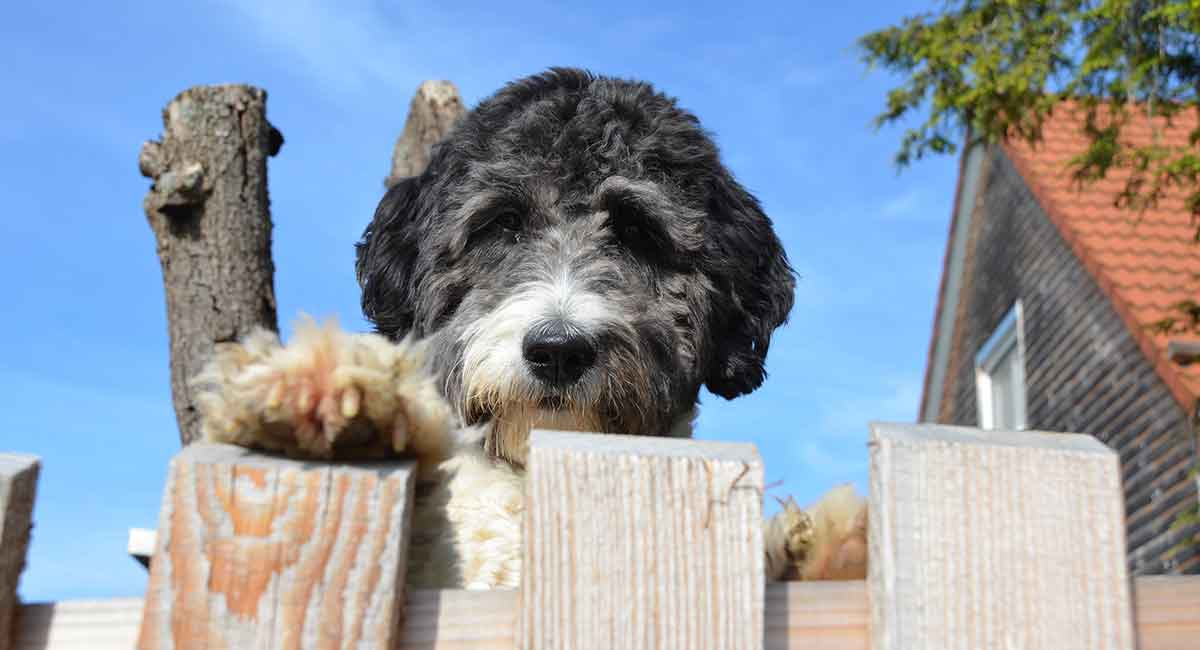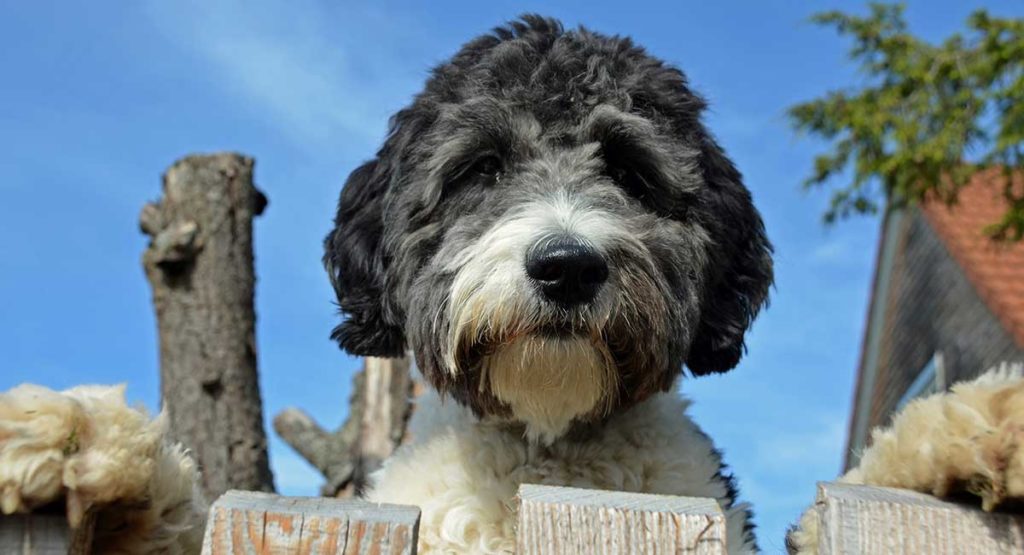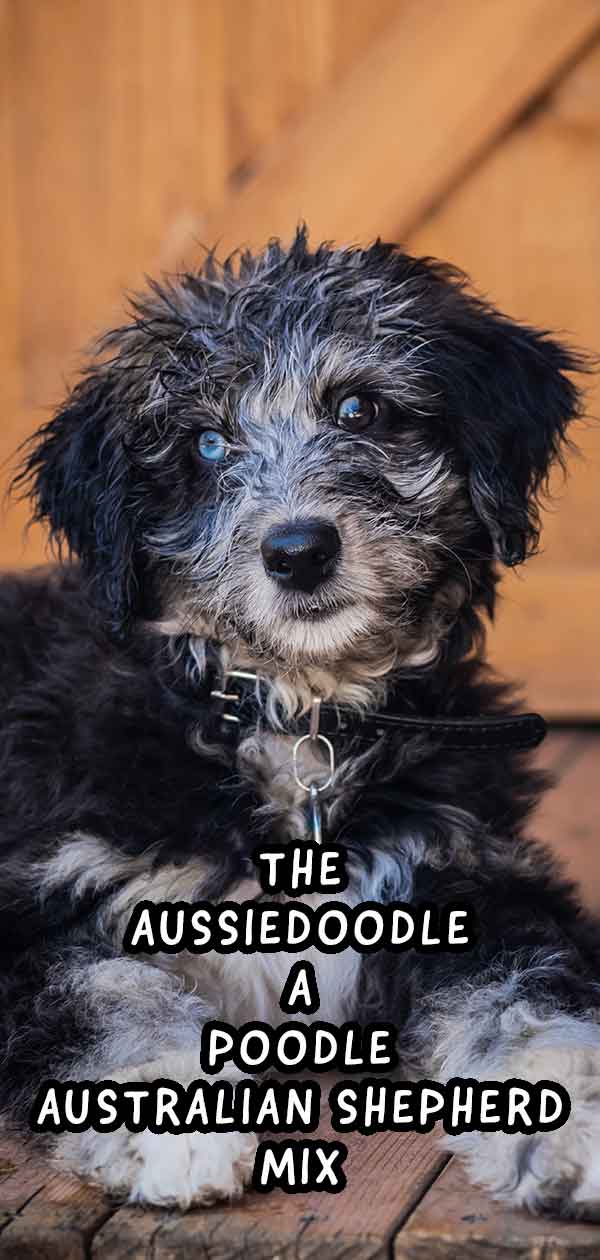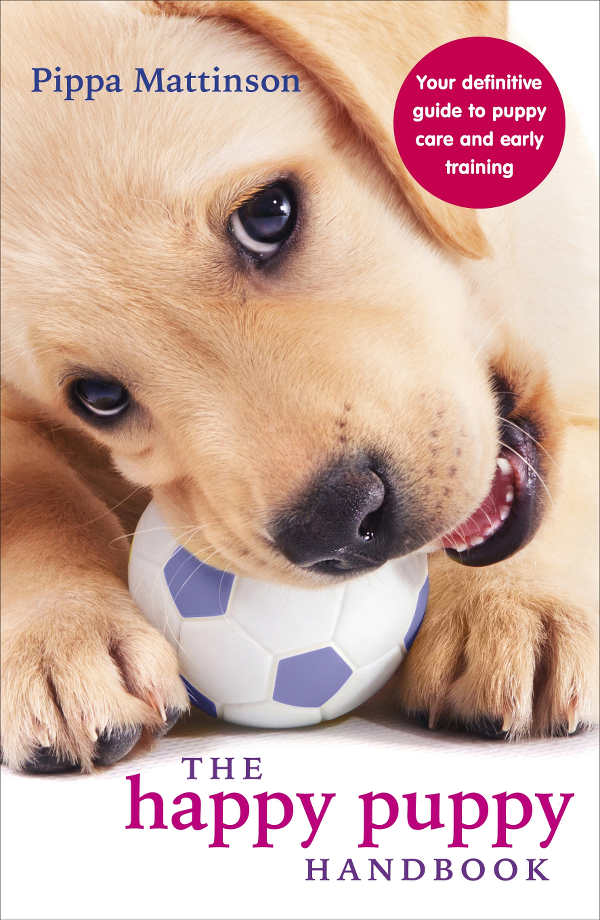
The Aussiedoodle seems to have it all, but there are some drawbacks to having a high powered puppy in your home. Today we take a look at the pros and cons of Aussiedoodle dogs. Helping you to decide whether the Australian Shepherd Poodle mix is the right choice for your lifestyle.
- Australian Shepherd and Poodle history
- How big are Aussiedoodles?
- Grooming and coat care
- Poodle Australian Shepherd mix personality
- Aussiedoodle puppies
The Australian Shepherd Poodle mix, is a cross between two of the world’s brainiest and most beautiful breeds. The Aussiedoodle is a very active, intelligent and eager to please dog. Strongly bonded to their family, they are keen to spend most of the day working closely together.
What Is An Aussiedoodle?
The Aussiedoodle is bred from an Australian Shepherd parent and a Poodle parent. Clever, energetic and playful, they are working bred dogs at heart. Because Poodles come in three different sizes, an Aussiedoodle can weigh anywhere from 10 – 70lbs.
Where Do Aussiedoodles Come From?
The Aussiedoodle is a cross between the purebred Australian Shepherd and the purebred Standard Poodle. Also known as the Australian Shepherd Poodle mix, the Australian Shepherd Poodle, the Aussie Poodle Mix, or even the Aussiepoo, they can come from smaller Poodle mixes but this is less common.
This is a newer crossbreed, but we can find out a lot about them, their genetics and how you can expect your puppy to grow and develop by looking at their parents’ rich working histories.
Australian Shepherd orgins
Both the Australian Shepherd and the Poodle have fascinating roots that eventually led to the intelligence, loyalty, and all-around cuteness that makes up their Aussiedoodle offspring. The Australian Shepherd is an all-American dog who was refined in California during the 19th century.
This breed was a staple as the cowboy’s best friend, utilizing his smarts as a herding and ranch dog in the American West. In fact, the Australian Shepherd is still one of America’s favorite herding dogs on ranches all over America.
History of the Poodle
The Poodle, often referred to as the “French Poodle,” and is the national dog of France. But the Poodle originally hails from Germany, where he was utilized for hunting ducks. Over 400 years old, the standard Poodle breed may be most famous for his fanciful coat. But did you know that his extravagant haircut actually had a purpose that went well beyond vanity?
Back in his working days, the Poodle would swim in cold, harsh water conditions to retrieve ducks for their hunting masters. And thus the famous Poodle haircut was born! Created to protect the Poodle’s sensitive body parts and also allow him agility in the water, the Poodle’s pompons are now a staple in Poodle coat culture.
What Do Aussiedoodles Look Like?
Since the Aussiedoodle is a crossbreed, the Aussiedoodle appearance is going to depend on that of his purebred parents. This appearance can vary quite massively, so don’t expect every Aussiedoodle puppy to look the same! Looking at the parent breeds can help us make an educated guess about the Aussiedoodle’s appearance.
No two Aussiedoodles look exactly the same. Even their facial features and structure can vary depending on what they inherit from their parent breeds! The Australian Shepherd has erect ears and bright eyes that are brown, amber, or even blue. The Poodle, on the other hand, has dark oval eyes, with ears that hang close to their head! So the face of your Aussiedoodle can be quite hard to predict!
Aussiedoodle Size
The Australian Shepherd stands about 18 to 23 inches tall and weighs around 40 to 65 pounds. The Poodle, on the other hand, comes in three size varieties:
- Standard: The Standard Poodle is the largest of the three size varieties, standing over 15 inches tall and weighing 40 to 70 pounds!
- Miniature: Medium in size, the Mini Poodle is between 10 and 15 inches in height and weighs between 10 and 15 pounds.
- Toy: Tiniest of the Poodles, the Toy Poodle grows to a mere 10 inches tall and only weighs four to six pounds.
Your full grown Aussiedoodle could range in size from 10 to over 15 inches tall and weigh anywhere from 10 to 70 pounds, depending on if he is a standard, toy, or miniature Aussiedoodle. However, most breeders use a Standard Poodle, so the average weight of an adult Aussiedoodle full grown is around 40 to 70 pounds. You should prepare for a medium to large dog.
Mini Aussiedoodles
The Miniature Aussiedoodle is bred from a Mini or Toy Poodle, and can be as small as just 10lbs in weight!
Aussiedoodle Coats
The Standard Poodle Australian Shepherd mix tends to have a curly or wavy coat, at least medium lengthed and with an undercoat.
The Australian Shepherd has a double-layer, waterproof coat perfect for his ranching days! His undercoat is thick, and his outer layer is longer on his body and a bit shorter on his face. The Poodle has a unique curly coat that most people love in a hybrid because it is low-shedding. However, it’s important to remember, we can never guarantee the type of coat an Aussiedoodle puppy will inherit.
Australian Shepherd Poodle mix colors
Just like every other part of the dog, its coat colors will depend on what it inherits from its parent breeds. The Aussie comes in six standard coat colors, including:
- Blue Merle
- Red Merle
- Black
- Red tricolor
- Black tricolor
- Tan
The Poodle, whether standard, miniature, or toy, has a thick curly coat that can come in several color varieties, including:
- Black
- Apricot
- White
- Cream
- Tan
- Blue Belton
- Blue
- Silver
- Sable
- Brown
This shows the huge variety that your Aussiedoodle could inherit! There’s no sure way of knowing just how your Aussiedoodle puppy is going to look until it arrives, but they will include one or more of these shades!
Aussiedoodle Grooming
You’ll want to be sure you have the right tools to keep his coat looking its best and to keep as much loose hair out of your home and off of your clothes as possible. The Australian Shepherded is a seasonal shedder. For this reason, he requires weekly grooming to keep his coat looking its best and free of mats and tangles.
The purebred Poodle, on the other hand, requires significant grooming. Especially if an owner wants to show him. Most owners who opt to show their Poodles will either learn to cut their fanciful coats themselves or they will go to a groomer. Other owners who are not interested in showing may opt for a puppy cut. This means they forgo the Poodle’s famous pompons and go for a more manageable cut.
Keep in mind that the Aussiedoodle is an active dog who may leave the house clean and come back dirty. Still, unless he comes back covered in mud, he really only requires occasional bathing.
Are Aussiedoodles hypoallergenic?
Aussiedoodles are not hypoallergenic and will have varying levels of shedding depending upon their coat type and which parent they take after.
The Poodle is considered to be a great choice for allergy sufferers. This is because they shed significantly less than many other breeds and produce less allergy-inducing dander on their fur. However, the Australian Shepherd is a shedder, and since you’ll be dealing with a crossbreed between the Australian Shepherd and the Poodle, chances are he will not be “hypoallergenic.” Because of the different types of coat your Australian Shepherd Poodle puppy could inherit, shedding and grooming go hand-in-hand.
General care
All Aussiedoodles need their ears cleaned regularly to avoid waxy build-up and moisture that could lead to infection. They will also need their nails trimmed frequently to keep them from breaking and cracking. As far as diet, the active and athletic dog will benefit from a high-quality dog food with meat proteins listed as the first three ingredients. They will also need fresh water every day and plenty of exercise and mental stimulation.
Aussiedoodle Temperament
Just as it is with size and appearance, the Aussiedoodle temperament will vary depending on what he inherits from his parent breeds. We can confidently say the Aussie Poodle mix is going to be a pretty intelligent crossbreed. Considering his parents are two of the smartest purebreds around. But, there are a few other traits your Aussiedoodle could inherit.
Both the Australian Shepherd and Poodle breeds are working dogs. This means they need lots of mental stimulation to keep them from getting bored. As they’re also both energetic and playful, the Aussie and Poodle both require lots of playtime and exercise. They love the outdoors, and enjoy getting messy. The Aussiedoodle is likely to inherit these qualities, making them an especially great choice for families with kids!

Are Aussiedoodles good with other pets?
We’ve seen that both the Poodle and Australian Shepherd breeds are full of energy. Whilst this can seem like a great quality for Aussiedoodles, there can be a downside. If not harnessed correctly, this energy and intelligence could lead to destructive and territorial behaviors. So make sure you know just how much time and effort you’ll have to put into keeping a Poodle Aussie mix happy!
Aussiedoodles can inherit the tendency to bond very closely with his family. For this reason, he does not do well if left alone for long periods of time. A final point to consider is the risk of an Aussiedoodle with other household animals. Australian Shepherds do well with other pets, but as expert herders they may try to herd their family members about the home.
The Poodle also makes a great family dog and does well with children and household pets. But his hunting skills mean he has natural instincts to go after smaller animals. In case your Australian Shepherd Poodle cross inherits these natural instincts, it’s best to keep him away from smaller household pets like birds, hamsters, guinea pigs, etc.
Do Aussiedoodles make good family pets?
The Aussiedoodle is an active, intelligent crossbreed who will do best in homes with large, fenced-in yards. They will also benefit from owners who have prior experience with dogs and can train intelligent, high-energy breeds. You should also keep in mind that the Aussiedoodle is likely to bond strongly with their family. They may not tolerate being left alone for long periods of time.
Grooming and shedding may also be an issue, so allergy sufferers should take this into consideration when thinking about getting an Aussiedoodle. If you are an active owner who understands what it takes to train and care for a smart, active dog, then he may be the perfect companion for you!
Aussiedoodle Exercise
Australian Shepherds need at least an hour or two of exercise a day and an owner willing to teach him new tricks and give him some purpose. For example, fetching the paper each morning or helping to carry in groceries. Poodles are also people-pleasers from nose to tail. But they require plenty of activity and exercise to stay happy, just like the Australian Shepherd.
For this reason, it’s easy to assume your Aussiepoo is going to be a very energetic dog who requires plenty of mental and physical activity. This can be achieved in a huge variety of ways! Your dog will love exploring outdoors with you, as well as playing fun games. They may even inherit the Poodle’s love for swimming!
Training Your Working Bred Dog
Examining the trainability of the Australian Shepherd and Poodle is a good way of predicting how well the Aussiedoodle can take to training. Not for the novice owner, the highly-intelligent and energetic Australian Shepherd is a working dog through-and-through. This breed will be happiest with doggy jobs and consistent training.
Since they are so intelligent and loyal to their family members, Aussies are very easy to train.
However, they must begin training very early and owners should be prepared for the high amounts of energy these dogs have.
The Poodle is also an intelligent breed and training him should be a breeze as well. As long as owners are consistent, Poodles are eager to please and enjoy showing off. So your Poodle Aussie puppy should take quite well to training. Especially with positive, consistent methods from a young age!
Aussiedoodle socialization
Australian Shepherd Poodle hybrids make great pets. However, and with all dogs, we recommend early socialization and obedience training to help ensure they are well rounded and adaptable. Patience, early socialization, and obedience training are key for this active and smart breed.
Any dog crossed with an Australian Shepherd is especially encouraged to indulge in early socialization and obedience training. One of the main reasons Aussies and their crosses wind up in shelters is because they were not properly socialized and trained, and owners did not know how to rein in all that energy.
This goes for even the smallest micro Aussiedoodle types. Even the mini Aussiedoodle temperament will benefit from training and socialization.
Aussiedoodle Health
The Aussiedoodle crossbreed is going to be prone to whatever his parent breeds are prone to. Therefore, it is best to look into all health conditions associated with the Australian Shepherd and the Poodle.
The Australian Shepherd is most prone to hip dysplasia, eye diseases, sensitivity to drugs, and epilepsy. And the Poodle is predisposed to hip dysplasia, epilepsy, progressive retinal atrophy, Addison’s disease, thyroid issues, bloat, and hypoglycemia.
There is no guarantee your dog will get one of these nasty health conditions. However, the risk of these hereditary diseases can be slightly higher. To improve the quality of life in your pup, we recommend early health screening to ensure he is ship-shape. Early health screening could also help you to prepare for or even prevent certain health issues your Aussiedoodle may face in the future.
Mixed Breed Controversy
With fame, intelligence, and a good work ethic in his line, it’s no wonder the Aussiedoodle is becoming such a popular crossbreed!
There is some debate regarding whether a crossbreed is really just a mutt with a fancy name. However, connoisseurs of the practice insist that mutts and crossbreeds are very different. They point out that while mutts have a lineage of several different breeds in their bloodline, crossbreeds are the specifically chosen offspring of two purebred parents. This is where the term “designer dog” comes in.
Designer dogs vs purebreds
Purebred dogs are bred for generations to maintain certain characteristics inherent to the breed standard. But they suffer some genetic health issues as a result.
Those who believe in crossbreeding hope that it could be a solution to this issue, reducing the chances of genetic health issues passed on to the offspring by widening the gene pool. However, other experts disagree and insist that crossbreeds are just as prone to certain health issues as purebreds. The important thing is to just do your research on your puppy’s parents, regardless of whether they are a mix or not.
Aussiedoodle Lifespan
Your Aussiedoodle is likely to have a fairly long lifespan of between 10 and 18 years, given the longevity of their parent breeds.
The Australian Shepherd has a lifespan of 12 to 15 years. Whereas, the Poodle has a lifespan of 10 to 18 years. Therefore we can expect that a healthy Aussiedoodle will live well into its teens.
Rescuing an Aussiedoodle
If you’re looking for an Aussiedoodle but don’t mind about qualities like age, you might want to look into rescues.
Rescuing an Aussiedoodle is a great way to get the pet you’ve dreamed of, whilst giving an older dog a second chance at finding a great home.
Aussiedoodle Breed Rescues
If you’re looking to rescue an Aussiedoodle but don’t know where to start, take a look at these rescue centers.
- Aussie and Me Animal Rescue US.
- Lone Star Aussies US.
- Awesomedoodle US.
- Doodle Trust UK.
- Doodle Aid.
- Poo-Mix Rescue.
Aussiedoodle Puppies
The Aussiedoodle is an admired crossbreed, combining the brains and beauty of two very popular dog breeds! But how do you go about finding Aussiedoodle puppies? Local adverts are still a good place to go, as are personal recommendations. Look for a breeder than focuses on one type of dog, and has a purpose for them beyond making money.
The dog should know their owner, and respond to their name being called. Be sure to ask your breeder plenty of questions. And keep in mind that reputable breeders will be able to provide health certificates proving their litters have been screened for any inheritable health conditions.
Avoid puppy mills and pet stores when buying an Aussiedoodle, because these pups and their parents are often treated poorly. If you need more help with choosing an Aussiedoodle puppy, check out our Puppy Search Guide.
How much do Aussiedoodle puppies cost?
If you are considering rescuing an Aussiedoodle dog from a shelter, keep in mind that finding one in your local rescue could be hit or miss depending on when you are looking. However, if you are willing to be patient, one of the many benefits of rescuing an Aussiedoodle is going to be the price, since shelters cost much less than breeders. Not only that, but most shelters will actually cover the initial vet fees! Still, there are adoption fees, but they are typically pretty low, running from $50 to $100 at the most.
If you are looking at Aussiedoodle breeders, keep in mind that the Aussiedoodle price is going to be much higher. Especially if your puppy’s parent breeds are show quality. Be prepared to spend anywhere from $500 to over $1000 for one when going through a breeder.
Helpful Puppy Products
We’ve seen Aussiedoodles are likely to be active dogs. If you’re struggling to find a high-quality food for your puppy or adult dog, check out these guides to finding the best food for Australian Shepherds. They might give you a good guide to finding the best food for the active Aussiedoodle.
- Choosing the right food for Aussie puppies.
If your Australian Shepherd Poodle mix inherits a Poodle coat, you might also want to find the best products for grooming. You might want to check out the best shampoo for Poodle fur. Or even the best brushes for Poodle fur so you can avoid the costs of groomers.

Pros And Cons of Getting an Aussiedoodle
So, we’ve looked at a lot of information about the Aussiedoodle. Let’s recap the best and worst bits of this breed, so you can see if it’s right for you.
Cons of the Aussiedoodle
- The Aussiedoodle has very high energy requirements.
- Its fur could need a lot of maintenance.
- They can’t be left alone for too long.
- Their natural instincts can make living with other smaller pets difficult.
Pros of the Aussiedoodle
- The Aussiedoodle takes well to training.
- They are good with children.
- Their fur may be low-shedding.
- They have quite long life expectancies!
Comparing the Aussiedoodle with other breeds
If you’re still not entirely sure if the Aussiedoodle is the best fit for your family, you might want to compare it to some other breeds. You could try looking at some otherAustralian Shepherd Mixes. Or some other Poodle mixes!
Similar Breeds
There are lots of other great similar designer breeds to the Aussiedoodle that you might want to also check out:
- The German Shepherd and Australian Shepherd Mix.
- The Cockapoo.
- The Labradoodle.
- The Goldendoodle.
- The Australian Shepherd Beagle Mix.
Related Articles
- The Australian Shepherd
- The Poodle
References And Resources
- Gough A, Thomas A, O’Neill D. 2018 Breed Predispositions to Disease In Dogs and Cats. Wiley Blackwell
- O’Neill et al. 2013. Longevity and Mortality of Dogs Owned In England. The Veterinary Journal, 2013
- Schalamon et al. 2006. Analysis of Dog Bites In Children Who Are Younger Than 17 Years. Pediatrics
- Duffy D et al. Breed differences in canine aggression. Applied Animal Behavior Science 2008
- Strain G. Deafness prevalence and pigmentation and gender associations in dog breeds at risk. The Veterinary Journal 2004
- Turcsan, Borbala et al, Owner Perceived Differences Between Mixed-Breed and Purebred Dogs
- Howell, Tiffani et al,Puppy Parties and Beyond: the role of early age socialization practices on adult dog behavior, Volume 6, pages 143-153
- Sutter, Nathan and Ostrander, Elaine, Dog Star Rising: The Canine Genetic System, Nature Reviews Genetics, Volume 5, pages 900-910
- Lowell Acumen DVM, DACVD, MBA, MOA, The Genetic Connection; a Guide to Health Problems in Purebred Dogs, Second Edition, 2011
- Purebred Vs Mutt-Common Objections to Mixed Breed Dogs
- Carol Beuchat Ph.D., The Myth of Hybrid Vigor in Dogs…Is A Myth

Donna M. Phillips` says
We have a 2 year old Yorkie male, who had a big sister yellow Lab that we lost to cancer last June. We have an opportunity of getting a year old female Aussiedoodle to be his new big sister, but after reading your information I don’t know if that would be such a good idea. Does anyone have a small breed dog with an Aussiedoodle that could shed some light on the matter?
Jennifer says
Introduce the Aussiedoodle to the Yorkie when they first come home with you as a very young puppy (8 weeks or so), and all will be fine. Socialization is key for any young dog to get them used to children and other animals.
It took my Aussie puppy and my 3 year old cat (who has never really been around dogs) about a day to become great friends!
Amy Smith says
Very very helpful!!
Amy Smith says
Very helpful!!
Tina Conforti says
I want one. I was looking for a black female toy poodle. Hard to find and are expensive. My kids want to get me one but didnt realize a pure breed costs. I fell in love now with tha Aussiepoodle. I want one. How much are they and are they hard to find. Want one for Easter.
Linda Keller-Zierold says
We have an Aussiedoodle puppy and she is now 4 months old. She is adorable and very affectionate. So far, she has been easy to train, although she has a slightly stubborn streak, but I think that all puppies do. She loves to play and has been a great addition to our family. She needs to be kept busy as she is very active. We are still waiting to see how large, or small, she will be, but it appears, utilizing your chart, that she will be in the mid-size range. She is also in the hypoallergenic realm, shedding very, very little, with fur that needs to be groomed and is already quite long. We are totally in love with her!